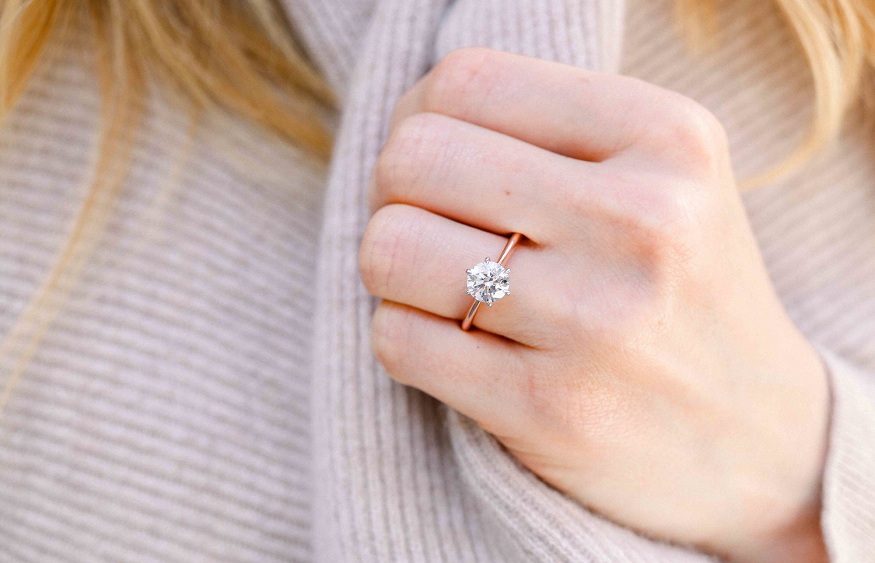Even though they are produced in laboratories by scientists rather than being formed naturally in the crust of the earth, lab diamonds are unquestionably genuine diamonds since they exhibit the very same chemical as well as visual qualities as natural diamonds.
You won’t be able to detect the difference with only your eyes, not even if you’re a trained gemologist; nonetheless, we’re giving you the opportunity to try anyway. The central stone of the engagement rings featured on this page is either laboratory-grown or naturally mined diamonds. Test your intuition to see if it can tell you which one is which! Get more information on lab-grown diamonds.
What exactly is a lab grown diamond?
The only difference between a Natural Diamond and a Lab grown Diamond is that the latter forms in a laboratory rather than the former’s natural habitat. There is no discernible difference in the appearance of lab-created and natural diamonds. They have the same degree of brilliance, are available in the same range of colors and clarity, and therefore can come in the very same dimensions and configurations. In a similar vein, lab-grown diamonds have a hardness that is comparable to that of natural diamonds.
The majority of both natural and lab-created diamonds are composed of carbon. The majority of natural diamonds include trace levels of nitrogen, but lab-grown diamonds do not include any nitrogen at all. This is the sole chemical distinction between lab-grown and natural diamonds. Gemologists are able to distinguish lab-created diamonds from mined diamonds because of the absence of nitrogen in the former. Additional characteristics that can be used to recognize lab-grown diamonds include laser engraving and a distinct glow.
Are diamonds created in a laboratory comparable in value to those mined from the earth?
The Rapaport pricing technique is an internationally recognized pricing mechanism that is used to determine the wholesale and retail prices of all diamonds, regardless of whether they were created in a lab or mined. This method assigns a value to a diamond based on its 4Cs, regardless of whether the diamond was mined or created in a laboratory. Regardless of where the diamonds were mined, the wholesale, retail, and resale costs are all calculated by deducting a certain percentage from the price shown on the Rapaport exchange. Having said that, despite the fact that you are capable of earning an estimated 30 percent more for a natural diamond upfront, you will most likely still obtain a better return on your investment with a natural diamond.
Despite this, no diamond should ever be considered an investment of any kind. Because the buyer wants to be able to make a living on the purchase, it is probable that the highest money you can obtain for your diamond would be around 30 percent less than what you paid for it when you first purchased it.
Gemologists are able to differentiate between natural diamonds as well as lab-grown diamonds based on a number of features that are created when natural diamonds, as well as lab-grown diamonds, develop differently. If you only look at the stone in the ring, it won’t be possible to perceive the difference.
The majority of naturally occurring diamonds can have their authenticity instantly verified by modern testing technology. A select handful will be forwarded to subsequent stages of testing. Lab grown diamonds may be identified one hundred percent of the time by diamond grading laboratories. In order to ensure that customers are aware of exactly what they are purchasing, laboratories typically engrave the phrase “laboratory grown” onto the girdle of lab-grown diamonds.
This is another reason why it is essential to be sure that the natural diamonds you purchase come with a grading certificate that has been issued by a reputable independent laboratory such as GIA that verifies their origin.
Comparing the Cost of Lab-Grown and Natural Diamonds
In this modern era, in which technology has totally taken over, it is easy to understand why the price of a diamond that comes from a natural source is far more than the price of its equivalent, which is a lab-grown diamond. Everything can be duplicated and recreated in today’s modern world. We are now residing in a simulated reality. Because of their scarcity and their origins in the earth, real diamonds serve as a link between us and our home planet. Consider this: would you prefer to consume foods that have been genetically modified or those that have been grown organically? The solution is straightforward, but it goes without saying that the disparity in cost is a consideration.
The cost of natural diamonds saw an increase of 15 percent to 30 percent in 2021. During the same time span, the price of diamonds produced in a laboratory fell by somewhere between 20 and 40 percent.
Natural diamonds continue to hold a special place in our hearts. We are of the opinion that the worth of diamonds is derived from the potent symbolism associated with them as a precious gift bestowed by the earth. We dress in
Diamonds have become the ultimate symbol of love, dedication, and accomplishment in the face of adversity, as well as a heritage that endures from one generation to the next because of their unbreakable character.

